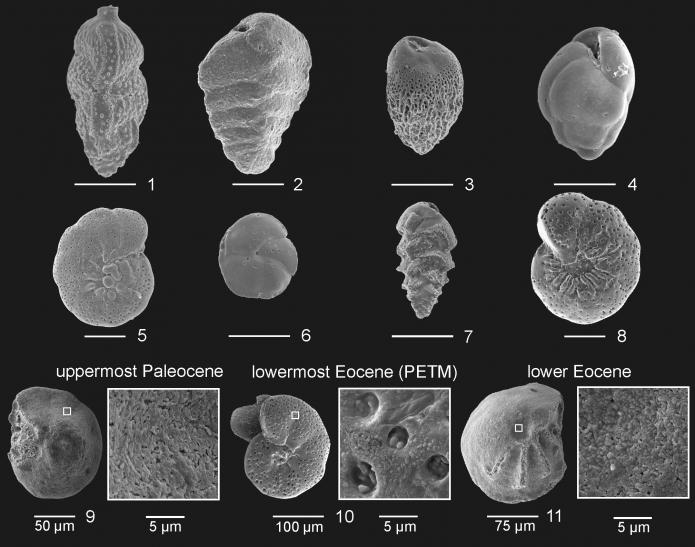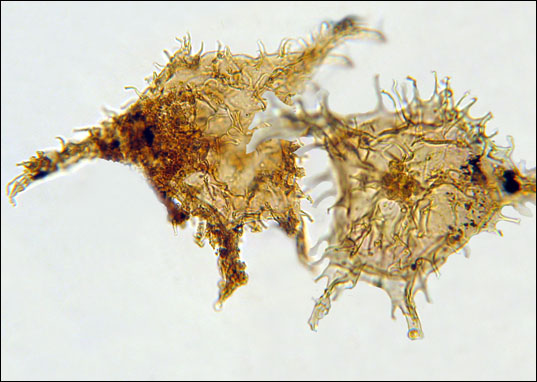PETM: Effects on Life
Before you read this section, please make sure that you have read the section on different fossil groups under Proxy techniques: Fossils and Rocks
Paleontologists have studied the response of many different groups of organisms in the PETM fossil record, from tiny plankton such as foraminifera in the oceans all the way up to small primates on land. The event also has a spectacular plant record, especially if you love tropical species. One of the prime areas on land is in the spectacular Big Horn Basin in Wyoming where geologists have scoured the rocks for primates and plant material and an exceptional record of the PETM exists, correlated precisely to the deep sea record using the carbon isotope shift. The land record shows the introduction of small primates and tiny ancestors to horses right near the beginning of the PETM along with a burst of tropical vegetation (refer to photos). It's almost impossible for the primates and horses to evolve so quickly, what is much more likely is that warming during the event led to the opening of land bridges in places such as Alaska and Siberia and that appearance in North America is merely an immigration from another continent such as Eurasia. The beautiful Big Horn plant record shows a change from moist subtropical vegetation before the event to dry subtropical vegetation during it. Imagine the landscape in northern Florida changing in a geologic heartbeat to that of dusty southern Texas.
The task of studying fossils is the ocean in part of the PETM is somewhat difficult. PETM cores from the deep sea are devoid of CaCO3 in the early part of the PETM as a result of acidification of the deep ocean. This acidification was so strong that shells that had already been buried on the bottom of the ocean also dissolved! The chief biological impact of the PETM was the mass extinction of deep-sea benthic forams. Approximately 35-50% of all species of this group went extinct during the event. Almost certainly, acidification was the main culprit, but it couldn’t have helped that the sea floor was often hypoxic and, in some parts of the ocean, food supply was limited. Life on the bottom of the ocean during the PETM was not fun, that is for sure!

Interestingly, the benthic forams were almost unaffected by the environmental impacts at the Cretaceous-Tertiary (K-T) boundary, a time when the dinosaurs and many other groups went extinct. This paradox reflects the fact that the PETM had a far more severe impact on deep-water environments, whereas the K-T boundary has more impact on the surface ocean and land.
Evidence for ocean acidification at the sea surface at the very outset of the PETM is more elusive, partially because the fossil materials of coccolithophores and planktonic foraminifera that would hold the evidence were dissolved as they rained down through the acidic deep ocean or lay on the seafloor. However, later in the event, the fossil record is spectacular. Coccolithophores display signs of deformation, which has been observed in modern species grown in the lab under elevated CO2. So, it could be that there was a minor amount of acidification in the ocean surface. This is confirmed by a proxy for pH based on boron isotopes. But acidification was clearly not the driver of change among animals and plants that lived at the sea surface.
Although extinction was focused in the deep sea, the PETM actually did result in abrupt changes to life in the surface ocean, one of the most dramatic of which was the occurrence of blooms of dinoflagellates in the coastal oceans.
These dinoflagellate blooms, which can be thought of as ancient red tides, are a sign of major environmental stress in the coastal zone possibly as a result of the increased runoff of water from the land. This runoff delivered nutrients from the land which resulted in a process called eutrophication which led to rapid blooms of algal growth and hypoxia on the sea floor. Elsewhere in the oceans, the environmental changes during the PETM led to shifts in the distribution of plankton groups, with tropical species invading the high latitudes and high-latitude species dwindling in abundance. As we said earlier, the tropics could have been like a warm bathtub (close to 100o F) so you can imagine all of these tiny coccolithophores and foraminifera fleeing these conditions in a mass exodus! Clearly, temperature was the big factor for surface plankton away from the coastal zone.
Another very cool aspect of the change in plankton is shown by the tropical and subtropical planktonic foraminifera, which contain a unique set of morphologies during the PETM. It’s unclear whether these morphologies represent new species or just variations of existing species, but it's pretty amazing that such variation arose in a geologic heartbeat and then disappeared at the end of the event. Quite possibly, these new forms represent the adaptation to a deeper environment, the species were forced to exodus the very surface of the ocean because of the uninhabitable conditions.
One final thing about the plankton during the PETM. At the end of the event, the distributions and abundance of different taxa reverted to close to where they were before. The structure of communities changed a little, but for the surface species, it was almost as if the event never happened. Life there was very resilient, but on the sea floor, it was a different story, life was altered forever.
The chief biological impact of the PETM was the mass extinction of deep-sea benthic forams. Approximately 35-50% of all species of this group went extinct during the event. Although extinction was focused in the deep sea, the PETM actually did result in abrupt changes to life in the surface ocean, one of the most dramatic of which was the occurrence of blooms of dinoflagellates in the coastal oceans.

These dinoflagellate blooms, which can be thought of as ancient red tides, are a sign of major environmental stress in the coastal zone, possibly as a result of the increased runoff of water from the land. Elsewhere in the oceans, the environmental changes during the PETM led to shifts in the distribution of plankton groups, with tropical species invading the high latitudes and high-latitude species dwindling in abundance. However, at the end of the event, the distributions and abundance of different taxa reverted to close to where they were before the PETM.
The burst of CO2 proposed for the PETM is consistent with the carbon isotope excursion as well as the rapid warming. Because the PETM involved very rapid warming and was caused by a burst of greenhouse gas, the event has been used to model the potential effects of modern climate change on life and the environment.
